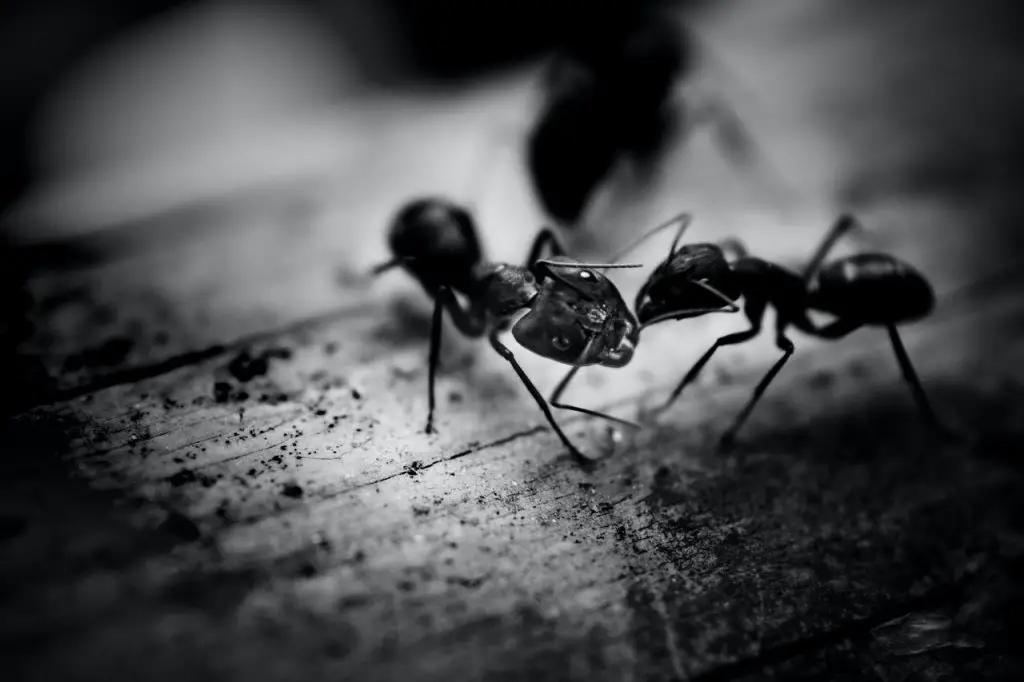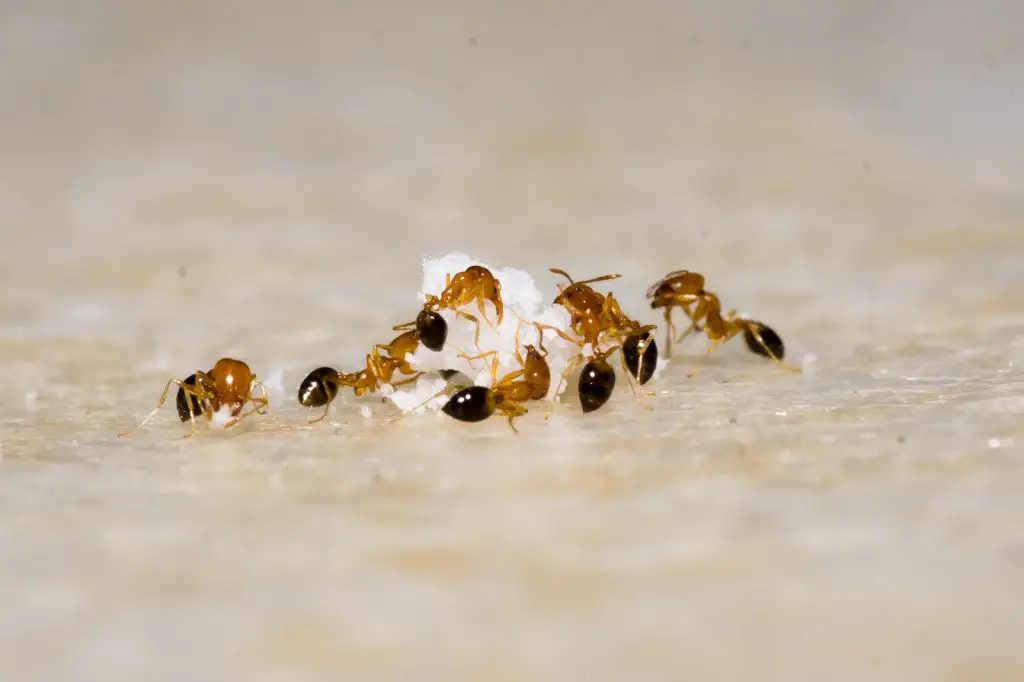We often see ants running in huge circles and wonder if this is a strategy to work together or are they trying to find food, there are other several questions that arise in our minds. Why do ants run in circles
Ants are known to run in circles in certain situations, often referred to as ant mills or death spirals.
Blind army ants rely on pheromones to trail other ants, but when a trail loops, they become trapped in an eternal cycle, running endlessly in circles.
During foraging, leading army ants leave pheromone trails that guide the rest of the group, who then detect and follow these scented paths.
Why do ants run in circles? Explained
When army ants, lacking visual perception, lose the guiding pheromone scent that connects them to their main foraging group, they initiate a pattern of following one another, resulting in a perpetual circular movement.
With no additional cues to guide them, they persist in this circular motion until exhaustion ultimately claims their lives.
As a highly coordinated collective, army ants thrive in their collaborative efforts.
Individually, an ant would struggle to survive, but together they nourish the entire colony and construct intricate tunnel systems.
Despite their blindness, army ants navigate and locate food by tracing each other’s scent trails.
This reliance on pheromones fosters a cohesive community akin to a “hive mind,” where the ants obediently follow one another, driven by the common goal of feeding the queen and sustaining the colony.
When the leading ant confronts a hindrance like a fallen log, a barrier, or a predator, it may need to alter its course or seek an alternative path.
This change in direction can confuse the following ants, triggering a frantic circular pattern as they pursue one another’s scents.
The original leader then follows a different ant’s trail, leading the entire colony into an infinite spiral.
Which species of ants run in circles?
Among the various species of army ants found in the Americas, one particular species exhibits a peculiar behaviour known as the “death spiral.”
Labidus praedator, completely blind and constantly on the move, forms massive groups that can reach up to 1,000,000 individuals.
These ants forage for food together, following a leader, and do not reside in permanent ant hills like other ant species.
How do ants communicate?
While ants lack the ability to communicate through speech, extensive scientific research suggests that they rely on pheromones, small chemicals, to interact with their fellow colony members.
Pheromones play a crucial role in maintaining communication among ants, as evident from their characteristic behavior of moving in lines, whether straight or in endless circles.
These chemical signals are widely utilized by ants to identify individual ants, determine their nest affiliation, and establish social hierarchy within the colony.

When did scientists discover about the Ant mill?
In 1936, scientist T.C. Schneirla made a fascinating discovery when he encountered a mesmerising sight of hundreds of ants spiralling endlessly.
This peculiar behaviour, known as ant milling, posed a perplexing challenge to evolutionary biologists and seemed to contradict Darwin’s theory of “survival of the fittest.”
Since then, numerous entomologists and evolutionary biologists have extensively studied army ants to unravel the mysteries of their behavior and explore the powerful influence of their pheromones on the collective mentality of the colony.
Can Ants Break Free from their Endless Circles?
Escaping the death spiral is a challenging feat for ants, but not entirely impossible.
External factors like strong winds or rain can disrupt the loop, although the chances of escape remain low.
In a study involving E. praedator, rain briefly halted some ants, but they were eventually pushed forward by their counterparts, perpetuating the spiral.
While rare instances of escape have been observed, ants often end up caught in the spiral again. While challenging, the possibility of escape exists, albeit unlikely.
Can You Stop Ants from Running in a Circle ?
You can stop ants from running in a circle by placing ant repellents or by creating diversionary food trails
Pleasant scents like flowers, candles, or inks can guide blind ants to escape the spiral.
Disrupting the rotating circle is crucial to prevent exhaustion and extend their lifespan. While challenging due to potential stings, intervening in their path is essential.
Take action to stop the spiral and save the ants from exhaustion and starvation.

The largest ant spiral ever recorded is?
A remarkable example of an ant mill measured an astonishing 1,200 feet in diameter, taking approximately two and a half hours for each ant to complete a circuit.
Apart from their circular movements, army ants are renowned for their remarkable efficiency as formidable predators in the animal kingdom.
How to stop an ant death spiral?
To rescue ants from the death spiral, offer alternative pathways that divert their pheromone-following behaviour. By providing new channels, ants can be guided out of the spiral and onto a different course.
Here are a few techniques:
Connect a food trail:
To intervene in the ant death spiral, connect a food trail that serves as a pathway for the ants.
By linking their pheromone trail to a new direction, you can guide them away from the endless spiral.
They recognize the food source and try to reach their target. You can change their path and move them out of the ant mill.
Create alternate channel
To redirect ants from a death spiral, introduce an alternative channel by offering moisture or enticing scents.
Flowers with pleasant fragrances or scented candles resembling sweet aromas can serve as attractive distractions.
Additionally, certain pen inks containing pheromones can be used to influence the ants’ path and guide them away from the endless circle.
Ant-repellants
To deter ants from specific areas, employ ant-repellant sprays or deterrents.
A mixture of cinnamon and coffee grounds proves efficient in stopping these insects.
Additionally, the scent of vinegar and mint acts as natural ant-repellants, effectively halting their locked movement.
Boiling water
While some resort to pouring boiling water over ant mills, it is important to consider the well-being of these insects.
This approach is considered cruel and can lead to their swift demise due to their vulnerability to high temperatures, unlike humans.
It is advisable to explore more humane strategies to address the issue.
How to create an ant mill?
A simple method to create an ant mill involves redirecting a few ants into a confined area where they are likely to follow their own scent in a continuous loop.
Biologist and photographer Alex Wild recalls instances where ants unintentionally formed spiraling patterns by exploring dinner plates in his kitchen and rediscovering their own trail.
Conclusion
After a lot of hard work and research we found the answer to why do ants run in circles. The fascinating phenomenon of ants running in circles, commonly known as the death spiral or ant milling, has intrigued scientists for decades.
The blind army ants rely on pheromones to communicate and navigate, but when their trails loop or they encounter obstacles, they become trapped in an endless circular motion.
This behaviour challenges traditional notions of survival and highlights the influence of pheromones on their collective mentality.
While it is difficult for ants to escape the death spiral, various methods such as providing alternative paths, using repellants, and disrupting the circular motion can help rescue them.
It is important to approach these situations with empathy and consider humane strategies to address ant behaviour.
By understanding and respecting the intricacies of these tiny creatures, we can coexist harmoniously with them in our shared environment.



